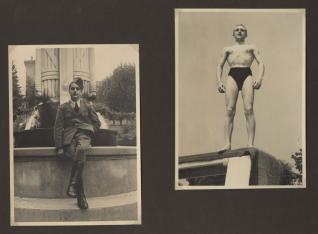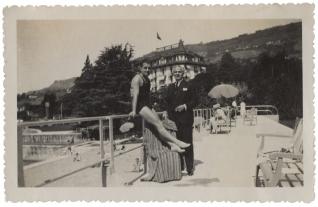Autochrome
Anonymous, Paris, circa 1930
Donation by the Maison Veuve Ambal
as part of the business patronage programme
A colour « slide » on a glass plate, the autochrome is a process invented by the Lumière brothers in 1904 and was used right up until 1935.
This process was a great popular success in as much as it contested and supplanted all of the competition despite a number of patents deposed during its production period by other companies. It reproduced colours by additive synthesis: a network of potato starch dyed with orange, purple or green pigments on which is spread a fine photographic emulsion in black and white. The autochromes were shown by slide projection or using specific equipment.
The musée Nicéphore Niépce has a large collection of autochromes, notably the Jules Richard collection (approx. 1 500 stereoscopic autochromes).
This recently acquired autochrome is unusual in that the subject matter is extremely modern: two women, two « friends », who are not visibly posing and are dressed quite daringly. Their haircuts are modern, their clothing is free and dares to reveal some skin, the glasses are an aside; it was a time of a certain freedom for women with the emergence of women’s fashion and the discarding of corsets and constraints. Women’s bodies freed themselves from bourgeois limitations.
This one-off autochrome, so unique in subject terms, bears witness to an era touched by modernity and is a necessary counterpoint to the traditional autochromes represented in the museum’s collections.

This collection of seven albums is remarkable in terms of its theme: it is a collection of albums composed of approximately 1 200 photographs illustrating the life of a homosexual and his friends in the twenties and thirties. The first album depicts the childhood of the main protagonist of the albums and presents photographs from his close family circle. The six others are chronological compilations of trips, everyday scenes, games, parties. Most of the photographs were taken in Switzerland, some were taken in France.
The six albums depict a homosexuality that is « out » in public places notably and presents all of the archetypes of homosexuality: portraits of sailors in uniform, soldiers, boxers, wrestlers and transvestites.
From a formal point of view the photographs reflect a body aesthetic that can be seen in the work of the photographers of the Nouvelle Vision : shots from above and below, some photomontages, a cult of the body that can be seen later in the work of André Steiner or Pierre Boucher for example.
The seven albums constitute an extremely rare testimony of sexual emancipation from the twenties in Europe. Berlin was the European capital of the homosexual milieu between the wars, a phenomenon that grew thanks to the presence of hundreds of bars, cabarets and homosexual associations as well as the existence of two magazines Die Freundin
(The girlfriend) and Garçonne
.
In France, the approach was more individual, but personalities like Marcel Proust or André Gide (publication of Corydon in 1924) contributed, through their work, to making the general public aware of homosexuality.
In Switzerland, a number of initiatives were set up to organise homosexuals and to fight homophobia. After a number of setbacks, the Schweizerische Freundschafts-Bewegung
(Swiss friendship movement) was set up in Basle and Zurich in 1931. Switzerland’s first homosexual magazine, Das Schweizerische Freundschafts-Banner
(The banner of friendship) came out on January 1st 1932 and from 1934 onwards benefited from the active participation of the actor Karl Meier, aka Rolf (1897-1974).
This collection constitutes an opportunity for the museum to enrich its collections with a rare example that is not or only rarely represented in public collections, of albums about homosexuality, a theme the museum has not covered until now





